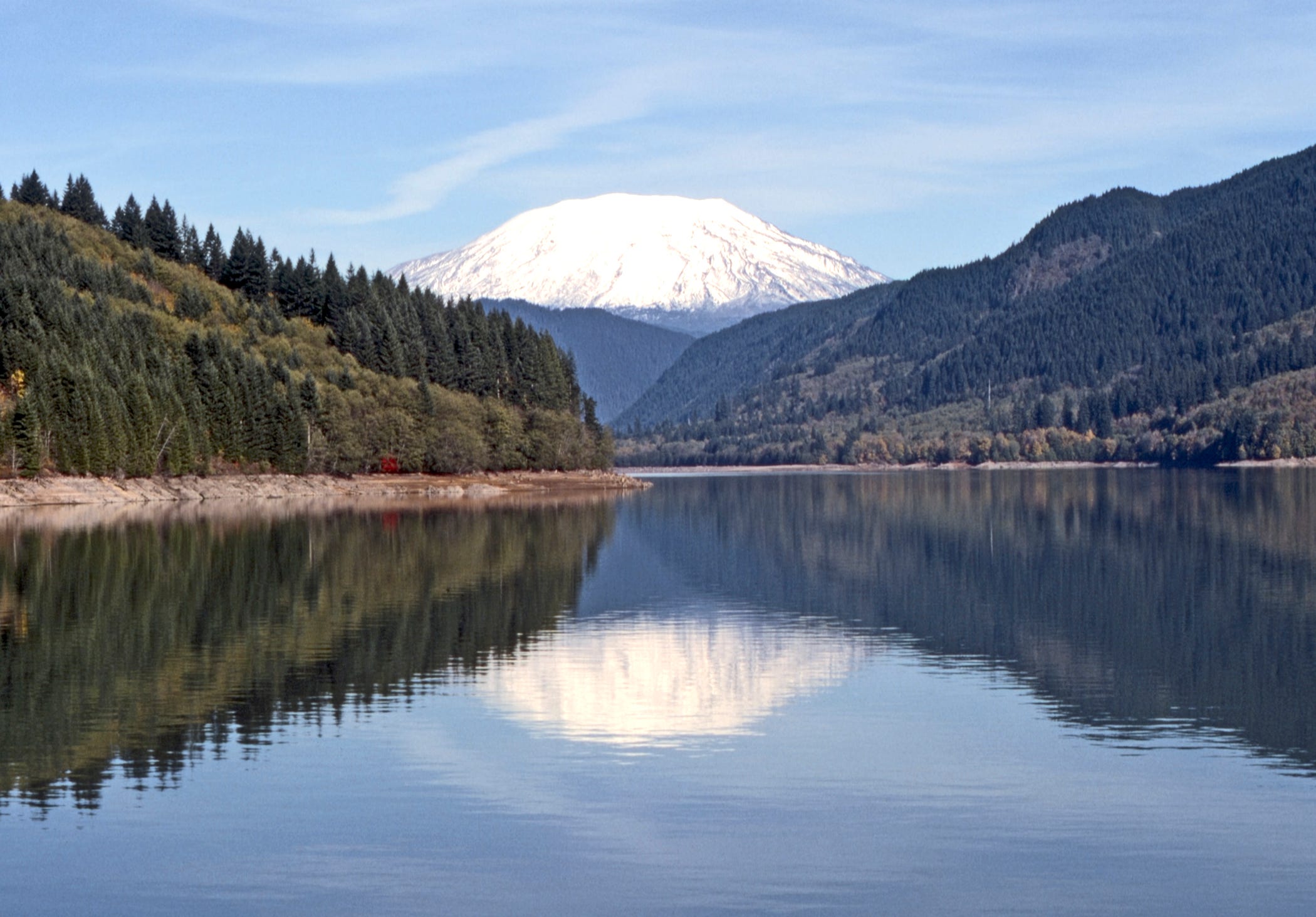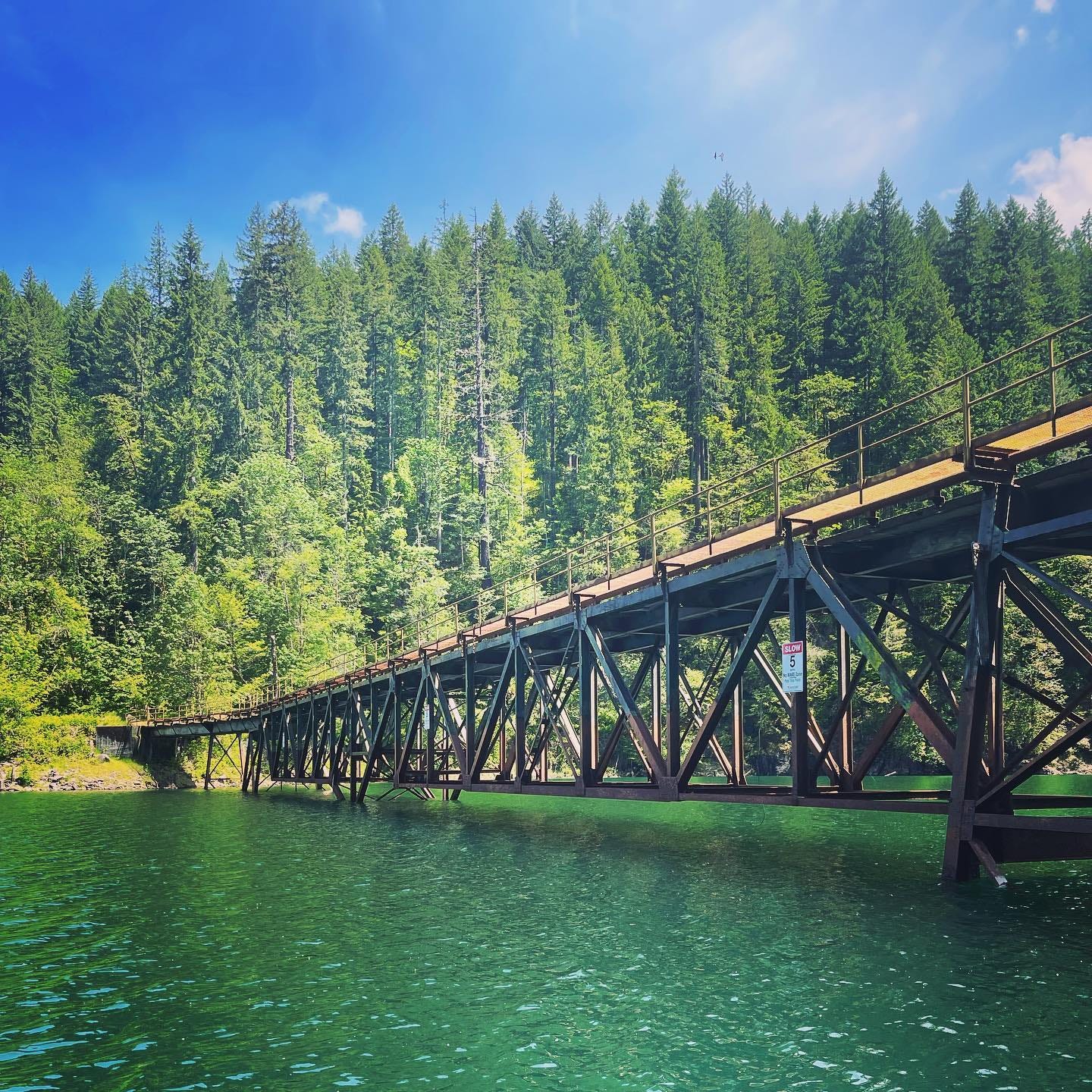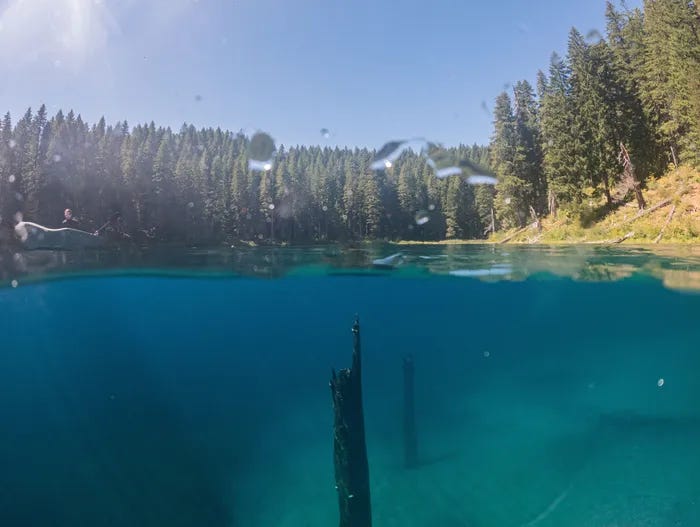“Fear is a childish thing, and though it may be natural, it is unworthy of a mature Christian soul.
—St. John Climacus (The Ladder of Divine Ascent, Step 21: On Unmanly and Puerile Cowardice)
Deep water terrifies me. I’m not even talking about ocean-deep. It can be any body of water where I can’t see the bottom. It’s the gloom and the unknown coupled with restricted movement when you’re in it. I first registered this fear at Yale Lake, which is just south of Mt. St. Helens in Washington State.
Yale Lake is, (or at least was, because I haven’t been there in several decades,) the place to water ski. That’s where I learned, in a freezing rite of passage that all my uncles and cousins went through.
There’s really no way to ease your way into it. Sure, you can start on a dock, where you stand in your two skis, waiting for the boat driver, (usually Dad), to putter into position until the rope is just taut and straight enough until he guns it and yoiks you into the water and, hopefully, skimming across the surface in an upright position.
I don’t remember that ever working for me. I have a vague memory of getting pulled OUT of my skis and doing a header into the drink.
No, more often than not you just have to do it. You jump off the back of the boat, somewhere out in the middle of the lake, a place no doubt farther than you would ever imagine swimming to, and into the water—water made freezing with snow run-off—and somebody slides your skis over to you. You’ve got the triangle at the end of the ski rope looped around your arm, nestled in the crook of your elbow, teeth chattering as you slip the skis on and tighten them.
It’s an awkward, bobbing mess of kid, skis, and rope, but somehow it works. Dad putters out ahead a ways until the rope is taut, dragging you along until you get everything lined up and in place, skis in front of you (because you do not want them to trail behind you, causing enough drag to pull you under—fast.) You push against the now substantial half-MPH pace, until you’re ready to suck it up and shout, “Hit it!”
Then the engine roars, the rope fights to pull out of your death grip on the bar, and if all goes well—and everything is aligned correctly—you pop right up on top of the water and…you’re water-skiing.
Eventually that’s the way it works. When you’re learning, more often than not, you’re, well, yoiked! right out of the skis, or you lose the rope, or maybe you get skipped across the water for a hundred yards or so, swallowing gallons of boat fuel-flavored water, until you remember to let go of the rope.
I make it sound like a bad thing. It’s not. For me and my clan, water skiing was indeed a rite of passage, and when you’re finally able to get up and on top of the water in that broiling wake, you know you’ve taken your place as a junior member of the clan.
Eventually you graduate from training wheels (two skis), by dropping one and going slalom. Then, perhaps halfway through the summer, you learn to start with just one ski. That’s where the real fun begins. This is where you start to get a little cocky.
Slalom skiing means you can really slice that water on the outside edges of your arc. It’s boring to be just dragged behind a boat, obviously. You want to get out of the wake where, ideally, the water is like glass. This usually happens in the morning. If you survive the launch and get up on that ski, the first thing you do is head out to “open water,” i.e. that soft glass outside of the wake, a semi-permeable membrane between sparkly sun, cobalt sky, and puffy white clouds…and the murky depths below. If you’re in the zone, the violent grinding sound of the boat’s engine fades away and it’s just you and the gentle swishing of the ski cutting through the water. Back and forth across the wake you go. If the speed is such that the wake creates a little jump, you can fly over the churned-up water to the other side and land in more smooth, glassy water.
It’s heaven. I’d forgotten until now, writing this piece from a dusty Oklahoma prairie. Where did those days go?
There was always an element of danger, of course. When you bite it, it’s usually a spectacular thing. I would rarely reach the end of my “turn,” and, signaling to the spotter behind the driver, dramatically cast the bar it into the air, letting physics and momentum do their thing, giving me a few brief seconds of totally unencumbered travel across the surface until drag and friction slowed, slowed, sloooowed me down until I descended into the lake like a foundering ship.
That was the graceful ending, and like I said: rare for me. The end of my water skiing sessions usually went like this:
I would be hot. I’d be cutting across the wake and into the glass so fast that I’d clear the other side of the wake by several feet at least. When I got to the outside of my arc, I’d hold the bar with one hand, my body almost parallel with the water, as though I was cleaning my armpit with speed and friction. And then I’d snap back for another wake-jump and down-low pit-cleaning on the other side.
That’s how I performed some of my most spectacular crashes. It always happened in less than a second. Don’t stick the landing after a wake jump? Smeared across the water. Lose my grip on the bar on the outside of the pendulum? That’s a barrel roll across it, and usually getting the wind knocked out of me. Hit the water butt-first somehow? Well, the first three feet of your lower intestine will be clean as a whistle.
That’s how it happened one day as Dad took us into this one little inlet on the eastern side of the reservoir. I believe it was called “Siouxon.” I absolutely hated that part of the lake. I had nightmares about it for years, probably, in part, because as legend had it, that’s where a skier who had just finished a run was beheaded. The story is that she ended her run and was standing up in the boat, toweling off, as they headed deeper into the inlet toward a very low bridge that runs across it. She had water in her ears, and didn’t hear the driver shout for everyone to stay low. She was facing toward the back of the boat, so she didn’t see it. The driver went through fast and, well, chop.
I didn’t believe that her head still bobbed in those waters many years later, but I was still very young and inexperienced with death. Even in the hot, bright summer sun, with a billion incandescent reflections on the ripples of the water, the not-quite-secluded cove felt like a liminal space, one of those thin boundary zones between worlds.
Even that, though, wasn’t the real terror of the place. It was the stumps.
Yale Lake is an artificial reservoir. It was once a tree-lined valley. So, when it was flooded, the water rose up above the tops of many of the trees and submerged them, a la the Great Flood. Above the surface of the water, you can still see that tree-lined valley, but below it is an underwater forest of bare, dead trees.
The first time I saw the underwater forest, we were near the Siouxon beheading bridge. It’s a cramped little bay, and I was always impressed at how my dad was able to navigate it even while towing a skier. The skier has to be cautious—trees poked up around the edges of the inlet, and you didn’t want to hit one. So, you play it carefully there.
Why would one want to ski in that cramped environment? The water was always glass in there. The best skiing in almost any weather. It was worth the risk.
I was doing my best to stay upright on one ski while Dad made the turn to head back out into open water. I was in the wake, looking over the edge and into the smooth glassiness just a few feet away. Spectral fingertips reached for the surface out of the blackness below. Dozens of them—some just a few feet under that surface.
I immediately froze up. Fortunately, I was balanced alright, so I didn’t just…tip over. At least not right then. I was afraid of the very real possibility that I could submerge deep enough to hit one of those underwater trees—a nightmare even without fears of running into any severed heads.
But, if I have any superpower, it’s manifesting the worst case scenario by thinking about it hard enough. Eventually, I went down. Maybe my ski hit a stick bobbing in the water, or maybe the terror seemed so unavoidable, so definite, that I might as well just give in and let it happen… I could only watch as my ski went left, I went right, nailing the churning wake at around 25 m.p.h…
Dad and the boat motored away. From the surface of the rapidly calming water, that boat seemed so, so far away. Around me, just under the surface, I could see those skeletal Nephilim fingertips all around me, close enough to touch with my bare foot, if I so chose to touch. I did not, of course. In fact, my legs sized up, knees to my chest, trying my hardest to get on top of the water if that was possible, and I was desperately trying to make it possible. The life jacket helped a lot—I don’t know what I would have done if I’d had to tread water. The ski floated nearby—I grasped it, although the added bouyancy was negligible at best. I was probably doing more to save it.
By the time my Dad came around and picked me up, I was well-and-truly checked out. Over what felt like an hour, I had expected something to dart up from the gloom to grab me, pull me to the dark depths, and devour me even while I drowned, but was likely only a minute or so.
“Want to go again?” Dad asked, looking down from his perch at the helm.
“Let’s just go back,” I said.
I started this piece with a completely different outline. It was to be a short, personal story about overcoming fear, followed by three main sections outlining several critical points, and then wrap it up with a tidy how-to. Instead, I got 2,000-word essay on water skiing. Haha. Figures. This is always how it goes.
However, this is actually my point: The fear is something I had to uncover.
It’s not a particularly relevant fear most of the time, although due to its many lakes and rivers, Oklahoma has 56,000 miles of shoreline and 200 manmade lakes…
Despite this fear, I was a high-functioning waterphobe: I more or less went about my days playing in the water, not quite pushing the fear aside, but…disregarding it. I might have been terrified of the gloom of deep water, but I sure spent a lot of time either diving into it, skiing on top of it, or sailing over it.
You might say that’s the correct way to handle fear. That’s the very definition of courage, right?
Sure—as long as you’re acknowledging it. If you’re not, the fear metastasizes into other things.
It might turn into arrogance because you want to hide your cowardice.
There’s anger, of course—how many times have we blown up over things that we later considered trivial?
The usual: we become workaholics because fear is a loss of control. Work is something we can control.
Perhaps the worst metastisization of all: reflexive cynicism. Bitterness. Sarcasm. I call this “worst” because its so UNmanly. It’s pathetic. It’s attaching an ideology to your fear that justifies and dismisses it, thereby guaranteeing that you’ll remain locked in a fear state.
I’ve been thinking about uncovering hidden fears for the last several weeks. Why? It’s time. Long past time.
It’s been almost 21 months since I came to the monastery. Roughly 18 months more than I intended. I’ve been walking around the decidedly dry and landlocked monastery grounds (no water skiing on this pond!), prayer rope in hand, heart in the ICU, mind everywhere and nowhere. I work on creative stuff in the mornings when I’m able to, then I do my various monastery duties, and then I go work my Hell job for eight hours. If I have anything left when I get home at night, (I work the late shift), I put in another hour or so of administrative stuff. Life stuff.
It’s a daily 18-hour grind that doesn’t leave room for much else. All the money I make goes to the family I don’t have anymore, more or less. There is marginal forward motion—I landed another audiobook narration gig, for example—but the needle barely moves, if at all.
Why?
It says something that it took about 20 months to really ask that question. No, I mean really ask that question—to turn around and square off against the smirking bully lobbing insults at me, and shout: “Why are you here?”
That led to another question, and another, which eventually led me to a thing I’d been afraid to consider.
It was a fear.
No, I’m not going to tell you what it is. Sorry. As it happens, there are some things too personal to share in this publication. No, it’s nothing weird. I don’t have a fish fetish or something. It’s just a fundamental thing. Something that’s been with me for 51 years. Closer to me than a shadow.
Now I know its name. Now I know how to deal with it, which is what I’ve been doing lo these last several weeks. The results have been great: Peace, confidence, and healthy control.
I think, if I were to become a counselor or a man-guru or something, I would begin sessions with men with this: “What are you most afraid of?”
They would likely tell me something common, like, “I’m afraid I’m letting my family down,” or, “I’m afraid I’ll never find love again.”
Then I’d ask them again: “What are you really afraid of?”
That would make them pause because…what do you mean? I just told you my deepest fear.” But I know—oh boy, do I know—that when you begin asking those follow-up questions, it shows that the path continues just on the other side of this dead brush. That path rounds the bend and goes deeper into the forest.
I would advise men to keep asking the question until they get to the end. And there is an end. Some of these fears are rooted in the infinite, but it’s possible—and necessary—to find their here-and-now manifestations and curb-stomp them.
Thanks for reading. This publication is, like me, a work in progress, so I appreciate you making it to the end.
A like, share, or subscribe would mean the world to me, and it would bring me that much closer to my goal to help men rise above their fears, restore authentic masculinity, reclaim their God-given leadership roles, and rebuild their households, communities and the world.






I remember waterskiing in my childhood too - lots of swallowing water, not sure I recall ever getting fully up!
I remember those very days. Here's a hint from your MA: sometimes the scariest things are in the boat.